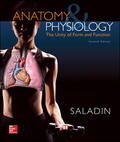
EBK ANATOMY & PHYSIOLOGY: THE UNITY OF
7th Edition
ISBN: 8220102796409
Author: SALADIN
Publisher: YUZU
expand_more
expand_more
format_list_bulleted
Concept explainers
Question
Chapter 15, Problem 17TYR
Summary Introduction
Introduction:
Pre- and post-ganglionic neurons are the functional components of the central nervous system. They are the neural circuits in which the command system from the brain passes to the preganglionic neurons that emit the neurotransmitter acetylcholine, and this in turn is received by the synaptic cleft of postganglionic nerve fibers. These postganglionic nerve fibers secrete the secondary neurotransmitter like norepinephrine into the target cells, which is received by the adrenergic receptors.
Expert Solution & Answer
Want to see the full answer?
Check out a sample textbook solution
Students have asked these similar questions
Generate one question that requires a Punnet Squre to solve the question. Then show how you calculate the possibilities of genotype and phenotype
Briefly state the physical meaning of the electrocapillary equation (Lippman equation).
Explain in a small summary how:
What genetic information can be obtained from a Punnet square? What genetic information cannot be determined from a Punnet square?
Why might a Punnet Square be beneficial to understanding genetics/inheritance?
Chapter 15 Solutions
EBK ANATOMY & PHYSIOLOGY: THE UNITY OF
Ch. 15.1 - Prob. 1BYGOCh. 15.1 - Prob. 2BYGOCh. 15.1 - Prob. 1AYLOCh. 15.1 - Prob. 2AYLOCh. 15.1 - Prob. 3AYLOCh. 15.1 - Prob. 4AYLOCh. 15.1 - Prob. 5AYLOCh. 15.1 - Prob. 6AYLOCh. 15.2 - Prob. 3BYGOCh. 15.2 - Prob. 4BYGO
Ch. 15.2 - Prob. 5BYGOCh. 15.2 - Prob. 6BYGOCh. 15.2 - Prob. 1AYLOCh. 15.2 - Prob. 2AYLOCh. 15.2 - Prob. 3AYLOCh. 15.2 - Prob. 4AYLOCh. 15.2 - Prob. 5AYLOCh. 15.2 - Prob. 6AYLOCh. 15.2 - Prob. 7AYLOCh. 15.2 - Prob. 8AYLOCh. 15.2 - Prob. 9AYLOCh. 15.2 - Prob. 10AYLOCh. 15.2 - Prob. 11AYLOCh. 15.2 - Prob. 12AYLOCh. 15.3 - Prob. 7BYGOCh. 15.3 - Prob. 8BYGOCh. 15.3 - Prob. 9BYGOCh. 15.3 - Prob. 10BYGOCh. 15.3 - Prob. 11BYGOCh. 15.3 - Prob. 12BYGOCh. 15.3 - Prob. 13BYGOCh. 15.3 - Prob. 14BYGOCh. 15.3 - Prob. 15BYGOCh. 15.3 - Prob. 1AYLOCh. 15.3 - Prob. 2AYLOCh. 15.3 - Prob. 3AYLOCh. 15.3 - Prob. 4AYLOCh. 15.3 - Prob. 5AYLOCh. 15.3 - Prob. 6AYLOCh. 15.3 - Prob. 7AYLOCh. 15.3 - Prob. 8AYLOCh. 15.4 - Prob. 1AYLOCh. 15 - Prob. 1TYRCh. 15 - Muscarinic receptors bind a. epinephrine. b....Ch. 15 - All of the following cranial nerves except the...Ch. 15 - Which of the following cranial nerves carries...Ch. 15 - Prob. 5TYRCh. 15 - Epinephrine is secreted by a. sympathetic...Ch. 15 - Prob. 7TYRCh. 15 - The gray communicating ramus contains a. visceral...Ch. 15 - Prob. 9TYRCh. 15 - Which of these does not result from sympathetic...Ch. 15 - Certain nerve fibers are called _______ fibers...Ch. 15 - Prob. 12TYRCh. 15 - Prob. 13TYRCh. 15 - Most parasympathetic preganglionic fibers arc...Ch. 15 - Prob. 15TYRCh. 15 - Prob. 16TYRCh. 15 - Prob. 17TYRCh. 15 - Prob. 18TYRCh. 15 - Prob. 19TYRCh. 15 - Prob. 20TYRCh. 15 - Baro -Ch. 15 - Lyto-Ch. 15 - Prob. 3BYMVCh. 15 - Prob. 4BYMVCh. 15 - Prob. 5BYMVCh. 15 - Prob. 6BYMVCh. 15 - reno-Ch. 15 - Prob. 8BYMVCh. 15 - Prob. 9BYMVCh. 15 - Prob. 10BYMVCh. 15 - Prob. 1TFCh. 15 - Prob. 2TFCh. 15 - Voluntary control of the ANS is not possible.Ch. 15 - Prob. 4TFCh. 15 - Prob. 5TFCh. 15 - Prob. 6TFCh. 15 - Prob. 7TFCh. 15 - Prob. 8TFCh. 15 - Prob. 9TFCh. 15 - Prob. 10TFCh. 15 - You are dicing raw onions while preparing dinner,...Ch. 15 - Prob. 2TYCCh. 15 - Prob. 3TYCCh. 15 - What would be the advantage to a wolf in having...Ch. 15 - Pediatric literature has reported many cases of...
Knowledge Booster
Learn more about
Need a deep-dive on the concept behind this application? Look no further. Learn more about this topic, biology and related others by exploring similar questions and additional content below.Similar questions
- In a small summary write down:arrow_forwardNot part of a graded assignment, from a past midtermarrow_forwardNoggin mutation: The mouse, one of the phenotypic consequences of Noggin mutationis mispatterning of the spinal cord, in the posterior region of the mouse embryo, suchthat in the hindlimb region the more ventral fates are lost, and the dorsal Pax3 domain isexpanded. (this experiment is not in the lectures).a. Hypothesis for why: What would be your hypothesis for why the ventral fatesare lost and dorsal fates expanded? Include in your answer the words notochord,BMP, SHH and either (or both of) surface ectoderm or lateral plate mesodermarrow_forward
arrow_back_ios
SEE MORE QUESTIONS
arrow_forward_ios
Recommended textbooks for you
 Human Physiology: From Cells to Systems (MindTap ...BiologyISBN:9781285866932Author:Lauralee SherwoodPublisher:Cengage Learning
Human Physiology: From Cells to Systems (MindTap ...BiologyISBN:9781285866932Author:Lauralee SherwoodPublisher:Cengage Learning- Understanding Health Insurance: A Guide to Billin...Health & NutritionISBN:9781337679480Author:GREENPublisher:Cengage
 Biology: The Dynamic Science (MindTap Course List)BiologyISBN:9781305389892Author:Peter J. Russell, Paul E. Hertz, Beverly McMillanPublisher:Cengage Learning
Biology: The Dynamic Science (MindTap Course List)BiologyISBN:9781305389892Author:Peter J. Russell, Paul E. Hertz, Beverly McMillanPublisher:Cengage Learning


Human Physiology: From Cells to Systems (MindTap ...
Biology
ISBN:9781285866932
Author:Lauralee Sherwood
Publisher:Cengage Learning



Understanding Health Insurance: A Guide to Billin...
Health & Nutrition
ISBN:9781337679480
Author:GREEN
Publisher:Cengage

Biology: The Dynamic Science (MindTap Course List)
Biology
ISBN:9781305389892
Author:Peter J. Russell, Paul E. Hertz, Beverly McMillan
Publisher:Cengage Learning
Dissection Basics | Types and Tools; Author: BlueLink: University of Michigan Anatomy;https://www.youtube.com/watch?v=-_B17pTmzto;License: Standard youtube license